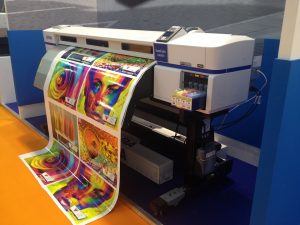Large Format Printing Basics
The demand for large format (wide format, grand format) printing services has increased as availability has increased and costs decreased. Some types of large format are
banners,
banner stands,
posters,
rigid signs,
window graphics,
floor graphics or wall graphics. It's used by advertisers, retail outlets, professionals, and private and home usage.

Large Format is "large" because the width is wider than that possible on sheet fed digital or even offset presses. The media (vinyl, paper, fabric) width is limited by the size of the rolls and the press it is printed on. The length is only limited by what is easily handled. However for larger products such as banners the pieces may be sewn together to achieve the desired width. Rigid signs are produced by printing on vinyl with an adhesive backing and mounted to the substrate (PVC, foam core, aluminum). Sometimes the work may be direct printed to the substrate on flat-bed printers.
Large Format Printing Basics – Considerations
Design Considerations:
- Easy-to-read fonts: Use fonts that are easy to read and large enough to be seen from a distance. Stick to two types of fonts if possible. Most importantly be sure that your text observes an at least 1" safety zone form the edge.
- Attention-grabbing colors: Our designer at AlphaGraphics can help you with your design however choose bold primary colors over pastels. Red and yellow are attention grabbing however be sure to coordinate with your logo or corporate color schemes.
- Uncluttered: Simplify your message. Signs are meant to be eye catching not wordy. Focus on a clear concise message. Use headers or bullets for clarity. Keep i mind that it especially true in signage that less is more.
- Bleed and Safety: Large format demands larger safety and bleed zones. Use at least 1" for safety zone. For bleed use at least 1/2".
File formatting:
- The number one rule to observe is to use a vectored based program in designing any graphics. Vectored art allows the image to be blown up or adjusted with out any blurring ( what is sometimes referred to as "jpegging").
- Photos should be of the highest resolution possible. At least 300 DPI. Your photo file is small (<100KB) it likely won't print well. You can sometimes tell how well the resolution will print by enlarging it on your computer screen to the final size. If it blurs around the edges on your screen it will blur when it prints. Photos found on the internet are most likely to low of a resolution to print.
- Use CMYK colors. Digital presses print in CMYK. If your files are saved in PMS or any other format that palette will be converted at least once by ripping software. Not all PMS colors convert perfectly to CMYK and certainly not the ones you've picked.
- Save your files in PDF or EPS format. Outline text as your print shop may not have that special font that you've selected.
Many different types of materials are used in large format printing. For indoor usage where weather or sunlight is not a concern a high quality
vinyl graphic is all that is needed. In applications that require durability or protection a laminate can be applied. Lamination will also sometimes brighten the colors.
Let AlphaGraphics Orlando help you design your large banner or sign for your trade show, convention, conference, or corporate event. Just give us a call at (407)896-2294 and ask about we can help your large format needs.